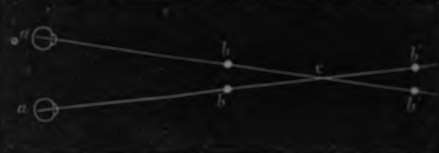Achromatism
Description
This section is from the book "Wonders Of The Human Body", by Auguste Le Pileur. Also available from Amazon: Wonders of the Human Body.
Achromatism
In ordinary vision objects appear to us in their natural colours distinctly defined, and not surrounded with the iris-like fringe which results from the decomposition of light. It would seem therefore that the eye is achromatic. But the experiments of Arago, Frauenhofer, and other scientific men, prove that it does not absolutely possess this property, though it is only when placed under abnormal conditions that we discover this. If, for example, we look at an object, and adapt the eye to an imaginary point, either in front of or beyond it, the image both becomes indistinct, and its edges become rainbow-like. If a body is placed near the cornea, in such a way as to cover a portion of the pupil, the same effect is produced.

Fig. 40. a, a. Globes of the eye. b b, b' V. Objects placed in front of or beyond the point of convergence of the two axes, c. Point of convergence.
Single Or Double Vision With Two Eyes
Although a separate image is produced in each eye when we look at an object, the object appears single under normal conditions of the sight, that is to say, when it is placed at the point at which the optical axes converge; but if the direction of one of these axes is changed, from pressing lightly with the point of the finger on the external angle of one of the eyes, for instance, the object appears double, and the images are separated more and more as the pressure is increased, and as it changes the direction of the axis more and more. On the other hand, two objects, one placed in front, and the other beyond the point of convergence of the two axes, but in the same direction, give but one impression, and we see but one.
Double or single vision with two eyes is explained by the correspondence of the terminal divisions of the retina in each eye. These are called the identical points. When the rays of light strike corresponding divisions in each eye, the sensation is single, but when they strike portions which do not correspond, it is double. This correspondence of the parts of the retina is shown by pressing lightly with the fingers on the closed eyes. If the internal or external angle of the eyes be pressed simultaneously, luminous images will be formed at the points directly opposite those which are pressed, and if the pressure be applied to the internal angle of one eye and the external angle of the other, or if we press the upper portion of one and the lower portion of the other, we see but a single image. From this we conclude that in the first experiment the two points pressed upon do not coincide because we see two distinct images, and that in the second they do correspond because we see but one. According to Muller, if we consider the retina as a sphere, the pole of which is the middle of the membrane or at some point in the same direction and at the same distance from the middle, the corresponding or identical points, on a section of this sphere, occupy the same meridian and the same parallel. Thus, in seeing with two eyes, the two images cause but a single sensation when they are formed on the corresponding portions of the retina, and consequently we receive a double sensation when they are placed on divisions which are not identical.
Continue to:
- prev: Myopia, Presbyopia
- Table of Contents
- next: Stereoscope
